The Quick Way to Tell if Something is Real Brass
Learn the quick way to identify brass vs. other metals. Tips and tests to distinguish real brass in everyday items
This guide will show you how to quickly identify brass from other metals. Learn the telltale signs and methods for accurate identification.
Do you love finding metal pieces when you are out thrift shopping or while at a flea market sale? Brass has become one of my favorite pieces to find for our home decor. I have found lamps, containers and so many candlesticks!
The candlesticks have a special place in my heart because they remind me of a certain special lady in my life. That story is for another day. Today, let’s figure out how to tell if something is brass!
Solid Brass: The Quick Way to Tell
When it comes to identifying solid brass items, there are several methods you can use. We’ll look at the most straightforward and accessible ways to distinguish this alloy from other metals. So, grab your brass items or any piece of metal alloy that you suspect might be brass, and let’s get started!

The following post may contain affiliate links. That means if you click and then buy something, I will make a small commission at no additional cost to you! Thank you for supporting my blog. full disclosure here.
Visual Inspection
The first and most basic method is a visual inspection. Brass has a distinctive appearance, characterized by a shiny yellow color, often with a warm, golden hue. However, keep in mind that the color of brass can vary slightly depending on its composition. Yellow brass and red brass are two common variations, with yellow brass having a brighter yellow shade.

Scratch Test
A simple scratch test can also help you identify brass. Take an inconspicuous or hidden area of your metal object and lightly scratch it with a knife or another sharp object. If the scratched area reveals a shiny yellow scratch, it’s likely solid brass. Be cautious not to damage valuable or antique items during this test.
See the candlestick above? Look in the top left corner, I used a small silver butter knife to scratch the surface and sure enough, it revealed a shiny surface underneath!
Magnet Test
One of the easiest ways to distinguish brass from other metals is the magnet test. Brass is not magnetic, so if a strong magnet sticks to your metal object, it’s definitely not brass. This test is particularly handy when sorting through scrap metal at a scrap yard.
You can see the results below. The candlestick on the left is pure brass. The candleholder on the right is one that I painted to look like brass. It is most definitely another type of metal!


Weight Comparison
Brass is denser than many other metals, so it tends to be heavier. If you have a piece of brass and a piece of a different metal alloy of similar size, the brass item will generally weigh more. A brass piece will have a certain feel to it and after much thrift store shopping, I’m getting the feel for it!
The Acid Test
For a more definitive test, consider the acid test. However, this method should be used with caution and only on inconspicuous or scrap pieces. I did not perform this test and I would warn against it unless you take all of the safety precautions!
You’ll need nitric acid for this. Place a drop of the acid on the metal surface, and if it turns green, it’s brass. Please note that this test can damage the metal, so use it sparingly.
See the drawer pulls below? They are plated and contain copper. That’s what causes the reddish tone you see.

The Flame Test
If you have a small piece of your metal, you can use the flame test. Heat the metal until it glows red and then let it cool. Brass will have a dull gold color when it cools down, while other metals may show different properties.
This might be a test that I try when my hubby lights up the woodstove in his new workshop. Until then, I’m sticking with the magnet test for brass!
Brass Plating vs. Solid Brass
Sometimes, you might encounter items that appear to be brass but are actually brass-plated. In this case, look for signs of wear or corrosion. Brass-plated items tend to reveal a different metal (usually copper) underneath when the plating has worn off.
Solid brass items, on the other hand, will maintain their brass appearance even with signs of wear.
The darker brass candlestick below is probably plated. The worn-off very thin sheet of brass plate reveals different metals of which I am not sure 🙂
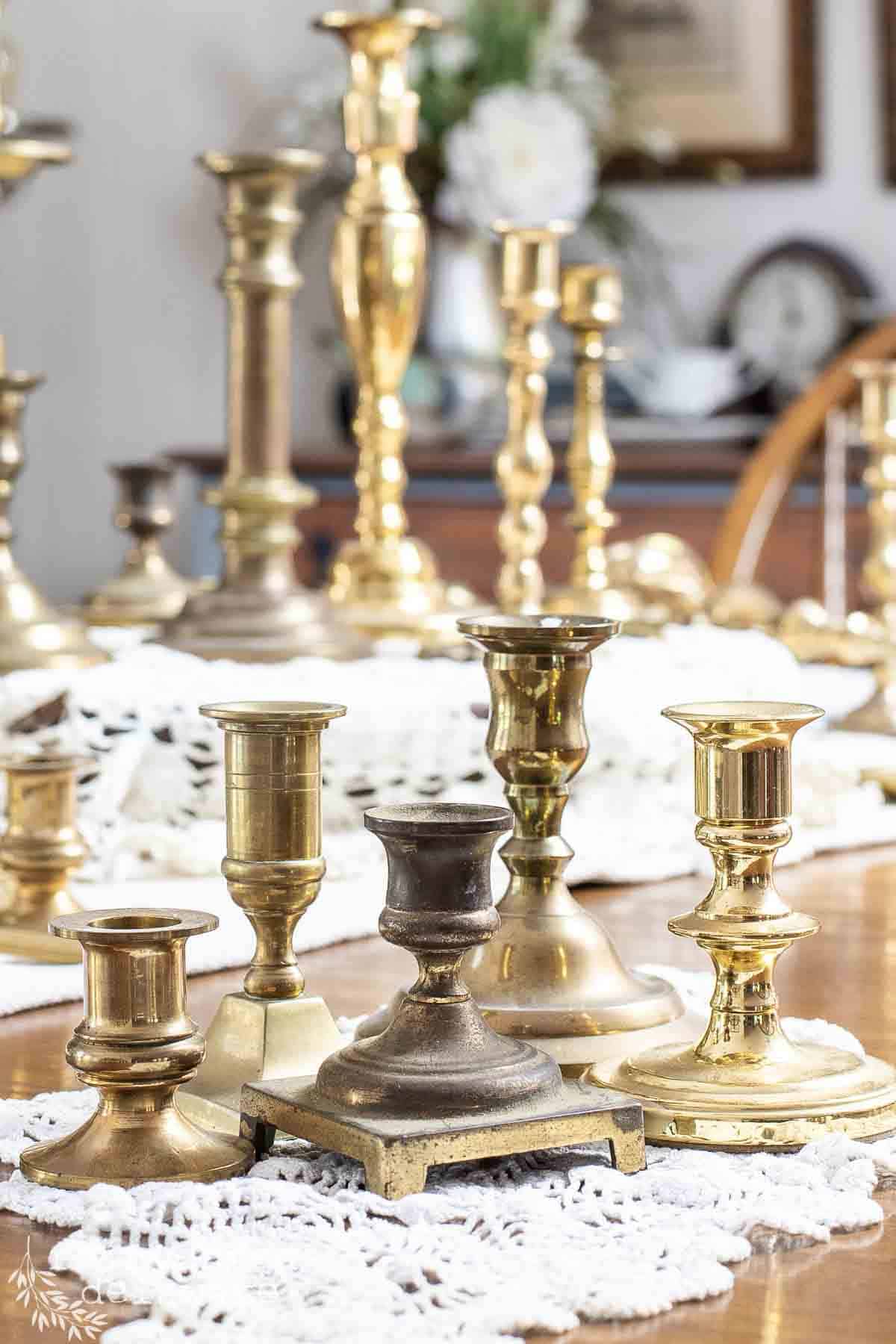
Compare with Known Brass
If you have access to a known piece of solid brass, comparing it to your suspected brass item can be a great way to confirm its identity. Look for color differences, weight variations, and other characteristics that align with brass.
Seek Expert Advice
When in doubt, seek advice from experts in the field, especially if you’re dealing with valuable or antique items. Professionals in the jewelry industry, antique dealers, and metal experts can provide valuable insights.
Your local jeweler can help and is an excellent way of determining the type of metal.

Why Does Identifying Brass Matter
Identifying brass is important for various reasons. Brass has a higher value than many other metals, making it a sought-after material in the scrap metal industry. It’s also a popular choice for antique items and decorative pieces. Knowing whether you have real brass or another metal can impact the item’s price, quality, and authenticity.
Additionally, brass is used in a wide range of specific applications, from musical instruments to home fixtures and industrial equipment. Recognizing brass allows you to make informed decisions about maintenance, restoration, or even the current price of brass items in the market.
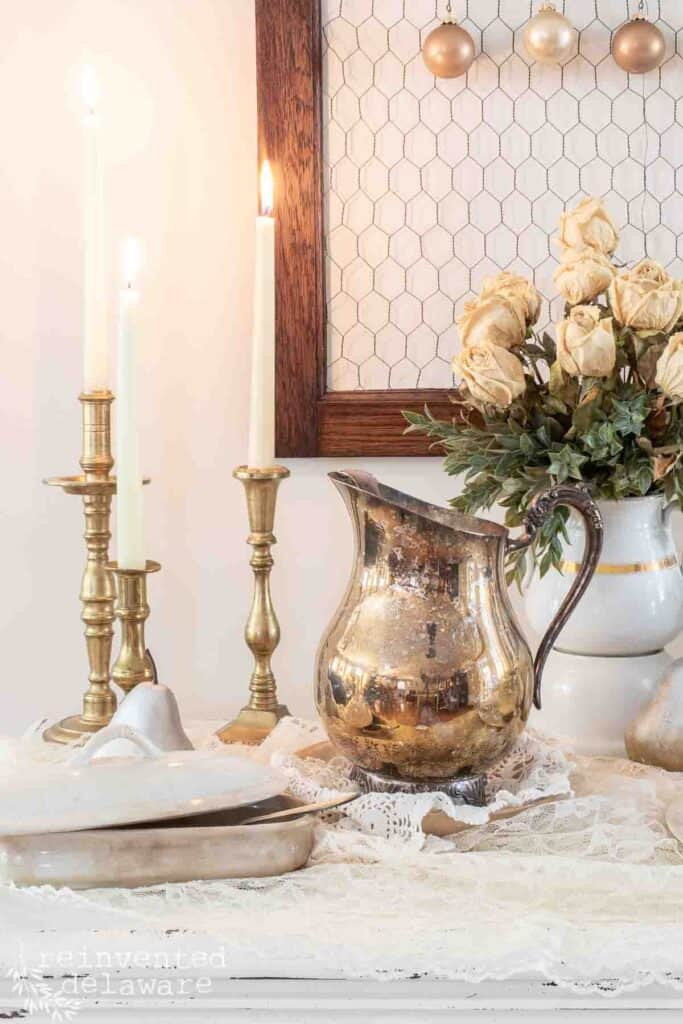
In ancient times, brass was considered a precious metal, and its value has endured through the centuries. Whether you’re a collector, a DIY enthusiast, or someone who simply wants to identify everyday items, these quick and easy methods will help you distinguish solid brass from other metals.
Handy tip: Keep a Magnet Handy!
When you are out thrift shopping, yard sale shopping or antique shopping, keep a small magnet with you! This is the best way to test different metals and determine if it is brass!
From musical instruments to home decor, knowing how to determine if your brass items are the real deal is a valuable skill that can save you from mistaking fake brass for the real deal.

FAQs: Everything You Need to Know About Identifying Brass
We understand that identifying brass may raise more questions. To address your concerns and provide additional insights, here’s an FAQ section:
What is the main reason to identify brass?
Identifying brass is essential for various reasons. It helps determine the value of items, especially when selling or trading scrap metal. Additionally, knowing if an item is solid brass or brass-plated affects its longevity and maintenance requirements. Antique collectors and enthusiasts also benefit from accurate identification.
Can I identify brass solely by its color?
While brass typically has a shiny yellow color, other metals may appear similar. Color alone isn’t always a definitive indicator. Using multiple identification methods, such as the scratch test or magnet test, will provide more reliable results.

What is the difference between yellow brass and red brass?
Yellow brass has a brighter, more yellowish appearance, while red brass tends to have a reddish or brownish tone. The main distinction lies in their composition, with yellow brass having a higher copper content and red brass containing more copper, zinc, and sometimes a small amount of lead.
Is brass magnetic?
No, brass is not magnetic. A strong magnet will not be attracted to brass. If a magnet sticks to a metal object, it’s not brass.
Don’t you love real brass drawer pulls like the ones you see on this antique washstand? this style is my favorite!
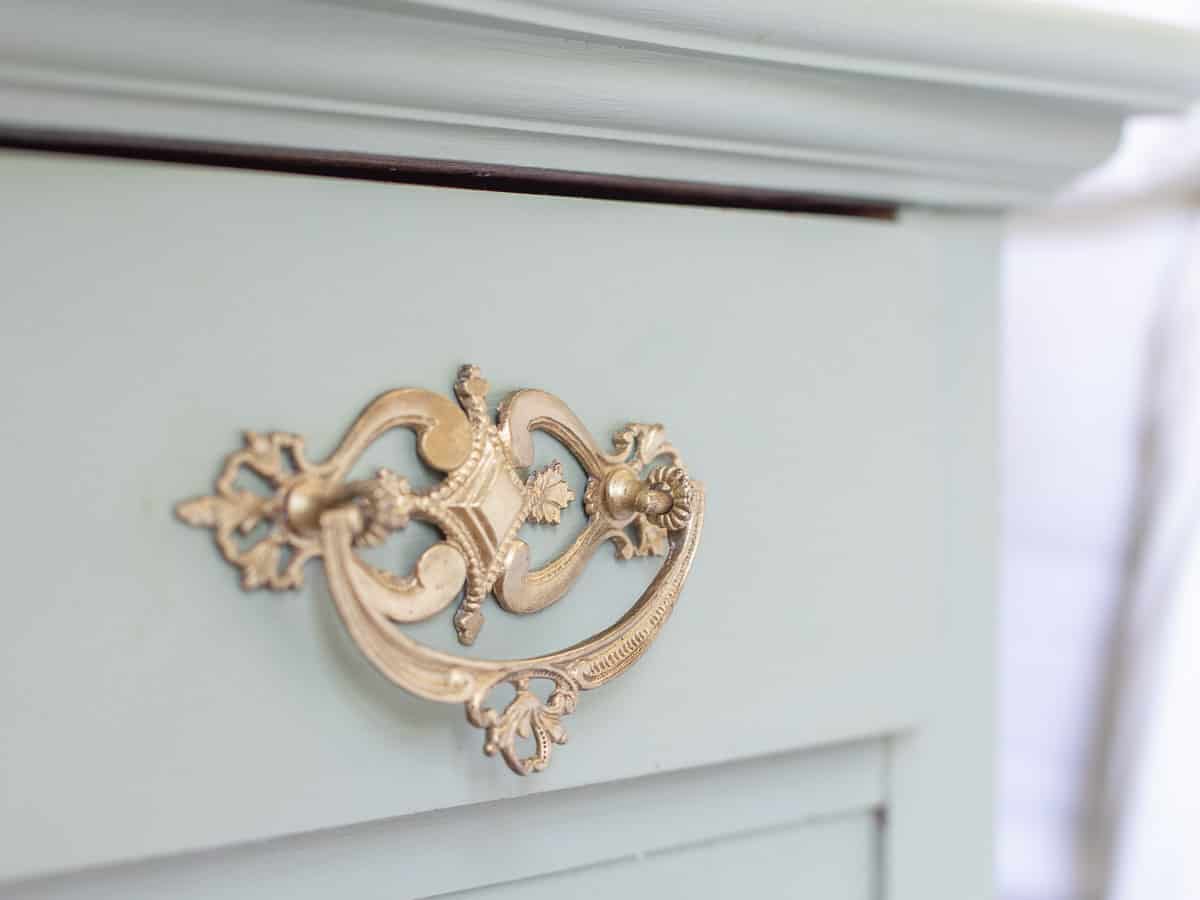
Can I use the acid test on any brass item?
While the acid test is a reliable way to identify brass, it can damage the metal’s surface. It’s best to use this test on inconspicuous or scrap pieces, especially when dealing with valuable or antique brass items.
I do not recommend this method due to safety concerns!

Are there any industrial applications for identifying brass?
Yes, brass is used in various industrial applications, such as plumbing fittings, electrical connectors, and machinery components. Identifying brass in these contexts ensures proper maintenance and replacement when necessary.
How do I differentiate between brass and stainless steel?
Brass and stainless steel may appear similar at first glance. However, stainless steel has a silver-gray appearance and is often non-magnetic. Using a strong magnet can help distinguish between the two materials.
Is brass corrosion-resistant?
Yes, brass is known for its excellent corrosion resistance, making it a popular choice for outdoor fixtures and marine uses. This resistance to corrosion contributes to its durability and longevity.

Can I determine the karat count of brass like I do with gold?
No, brass does not have a karat count like gold. Karat count is specific to gold and indicates its purity. Brass is an alloy (a combination of two metals) of copper and zinc, and its composition varies depending on the specific type of brass.
Are there any alternatives to identifying brass?
If you’re uncertain about identifying brass on your own, consider asking advice from experts, such as antique dealers, metal analysts, or professionals in the jewelry industry. They can provide valuable insights and confirm the composition of your metal items.
Can I identify brass in antique items found at flea markets or auctions?
Identifying brass in antique items is crucial for authenticity and value assessment. Utilize the methods mentioned in this guide to determine if the item is made of solid brass or if it’s brass-plated or composed of a different metal.

What are some specific uses of brass in everyday items?
Brass is commonly used in everyday items such as door handles, light fixtures, musical instruments, home fixtures, fireplace equipment, and decorative items. Its durability, corrosion resistance, and aesthetic appeal make it a versatile choice for various applications.
Are there any other metals that closely resemble brass?
Copper alloys, like bronze, can sometimes resemble brass due to their copper content. However, bronze typically has a redder tone, and its composition differs from brass. Other white metals, such as aluminum and zinc alloys, may appear similar but lack brass’s distinctive properties.

Are there any hidden areas on brass items where I can test without causing damage?
Yes, look for unnoticeable places or hidden areas where a scratch or mark won’t be visible, such as the inside of a handle or underneath a piece. This way, you can perform tests without affecting the item’s overall appearance.
Remember, identifying brass can be a valuable skill, whether you’re dealing with scrap metal, antique items, or everyday fixtures. Utilize these methods and seek expert guidance when needed to confidently identify brass in various situations.


Thanks for joining our journey!
So, the next time you come across a shiny, yellow metal object, take a closer look and remember these tips to determine if it’s truly brass or just another imitation. Happy brass hunting!
Thanks so much for joining us for this post! Join our journey so you don’t miss any of the fun projects, tutorials, and inspiration that we share with you each week! You can follow us on Instagram, Facebook, and YouTube. We share even more inspiration on Pinterest!
Visit my Amazon Storefront!
Click the button below and head over to our online shop on Amazon!


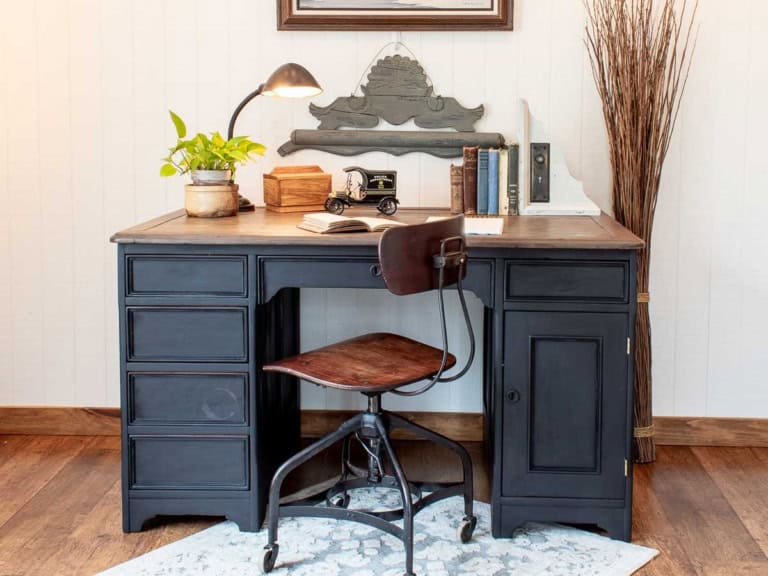
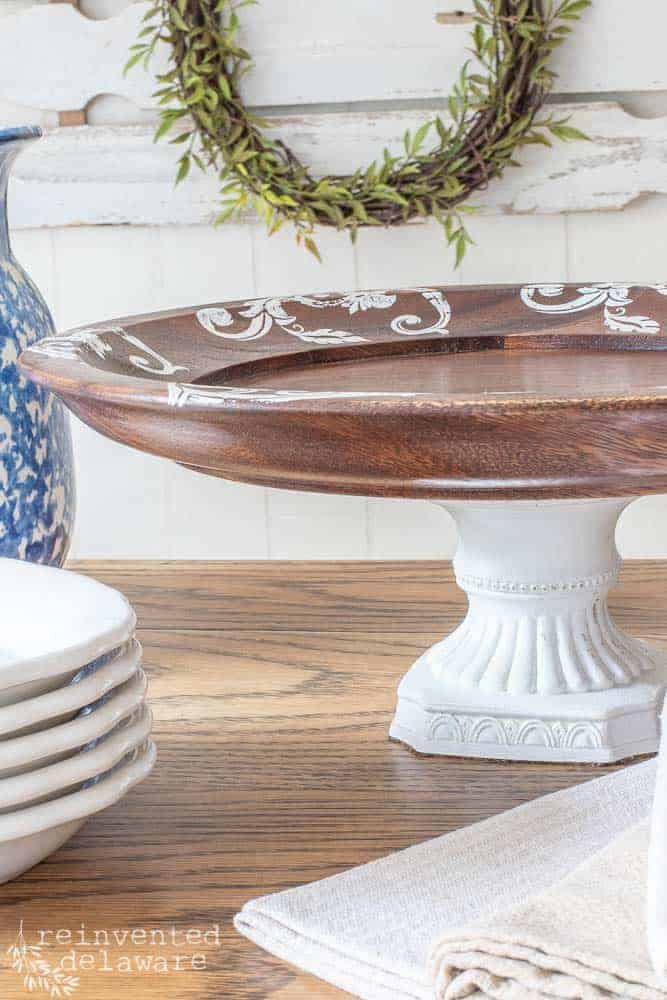

Cindy, I really enjoyed this post. You have good tips here on identifying real brass. I found this post extremely interesting.
Thanks Tammy! Brass is my latest obsession!
Enjoyed the post!!!
Thanks Melinda! I’m glad you found it helpful!